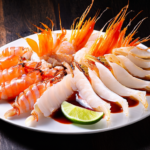Exploring the Flavors of Anhui: A Traditional Braised Mandarin Fish Delight
Welcome to our culinary journey through the rich and diverse gastronomy of Anhui Province in China. Known for its unique and intricate flavors, Anhui cuisine is one of the eight major cuisines of China, characterized by its emphasis on fresh ingredients and traditional cooking techniques. Today, we delve into the heart of Anhui cuisine with a classic dish – Braised Mandarin Fish. This dish not only highlights the region’s commitment to preserving traditional recipes but also showcases the delicate balance of flavors that define Anhui cuisine.
The History and Significance of Braised Mandarin Fish
Braised Mandarin Fish, or “Hong Shu Yu” in Chinese, is a dish steeped in history and cultural significance. Originating from the Huizhou region of Anhui, it has been a beloved part of local cuisine for centuries. The dish was initially prepared using the mandarin fish (also known as the orange-spotted snakehead), a freshwater fish native to the Yangtze River basin. Over time, the recipe has evolved, adapting to different regional tastes while maintaining its core elements of simplicity and elegance.
The preparation of this dish is often associated with celebrations and special occasions, reflecting the importance placed on family gatherings and communal dining in Anhui culture. The fish, symbolizing prosperity and abundance, is served whole, representing unity and completeness. This tradition underscores the deep connection between food and social customs in Anhui.
Ingredients
To prepare this authentic Anhui dish, you will need the following ingredients:
- Fresh Mandarin Fish: Choose a fish that is about 1-1.5 kg in weight for optimal flavor and texture.
- Soy Sauce: Essential for adding depth to the sauce.
- Rice Wine: Enhances the natural sweetness of the fish and adds complexity to the flavor profile.
- Scallions: Provides a mild onion-like flavor and complements the fish beautifully.
- Ginger: Adds a subtle spiciness and helps to remove any fishy odor.
- Garlic: Boosts the aroma and adds a savory element to the dish.
- Beijing Peanuts: These provide a crunchy texture and nutty flavor, enhancing the overall mouthfeel of the dish.
- Chili Sauce: For those who enjoy a bit of heat, chili sauce can be added to taste.
- Vegetable Oil: Used for frying the fish and sautéing the aromatics.
- Sugar: Balances the saltiness of soy sauce and rice wine.
- Water: Necessary for braising the fish and creating the flavorful sauce.
- Starch: Thickens the sauce and gives it a glossy finish.
Preparation Steps
- Cleaning the Fish: Begin by cleaning the mandarin fish thoroughly under cold running water. Pat dry with paper towels. Make several shallow cuts along both sides of the fish to allow the flavors to penetrate more easily during cooking.
- Marinating the Fish: In a small bowl, mix together soy sauce, rice wine, sugar, and a pinch of salt. Coat the fish generously with this marinade, ensuring each cut is well covered. Let it sit for about 30 minutes to allow the flavors to infuse.
- Frying the Fish: Heat vegetable oil in a large pan over medium-high heat until it reaches approximately 180°C. Gently place the marinated fish into the hot oil and fry until golden brown on both sides. Remove from the pan and set aside on a plate lined with paper towels to drain excess oil.
- Preparing the Sauce: While the fish is frying, finely chop scallions, ginger, and garlic. In a separate pan, heat some vegetable oil and sauté the chopped vegetables until fragrant. Add the fried fish back into the pan, ensuring it is fully submerged in the sauce. Pour in enough water to cover half of the fish. Bring the mixture to a boil, then reduce the heat and simmer gently for about 15 minutes.
- Adding Finishing Touches: Once the fish is cooked through, sprinkle Beijing peanuts over the top for added texture and flavor. Optionally, drizzle with a little chili sauce if you prefer a spicy kick. Finally, thicken the sauce by mixing a small amount of starch with cold water and stirring it into the sauce until it reaches your desired consistency.
Serving Suggestions
Braised Mandarin Fish is traditionally served whole, allowing diners to admire its presentation and appreciate the symphony of flavors. It pairs exceptionally well with steamed white rice, which provides a neutral backdrop for the bold flavors of the dish. Additionally, you might consider serving it alongside lightly stir-fried vegetables such as bok choy or snow peas to add color and freshness to the meal.
Conclusion
In conclusion, Braised Mandarin Fish stands as a testament to the culinary heritage of Anhui Province. Its preparation requires patience and attention to detail, but the result is a dish that encapsulates the essence of Anhui cuisine – a harmonious blend of simplicity and sophistication. By mastering this recipe, you not only gain a new skill in the kitchen but also pay homage to a cherished tradition. We hope you enjoy exploring these flavors as much as we do!


